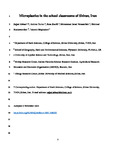Microplastics in the school classrooms of Shiraz, Iran
Date
2022-01Author
Subject
Metadata
Show full item recordAbstract
Microplastics (MPs) are a pervasive and ubiquitous environmental contaminant. However, very little information exists on the quantities or characteristics of MPs in the indoor setting. In the present study, MPs have been isolated from settled classroom dust samples collected from 50 schools in the city of Shiraz, Iran. Concentrations of MPs on a number basis ranged from about 80 to over 56,000 MP per g of dry dust and there was an increase in concentration towards the centre and southeast of the city. The geographical distribution is attributed to a larger population and student density, higher traffic loading and greater industrialization in the centre and southeast and a prevailing wind from the northwest. MPs were dominated by fibres of >250 μm in length, and Raman spectrometry and SEM-EDX analysis of selected samples revealed that MPs were mainly constructed of polyethylene terephthalate or polypropylene but were contaminated by various metals (e.g. lead, titanium, antimony) used as additives or acquired from the environment. Calculations using data for elementary schools indicate that children in the age range 6–14 years may be exposed to between about 5 and 440 MP day−1 through inadvertent ingestion. The health impacts of MPs on children are unknown but the results of the present study indicate a requirement for research in this area.
Publisher
Journal
Volume
Issue
Pagination
Number
Recommended, similar items
The following license files are associated with this item:


